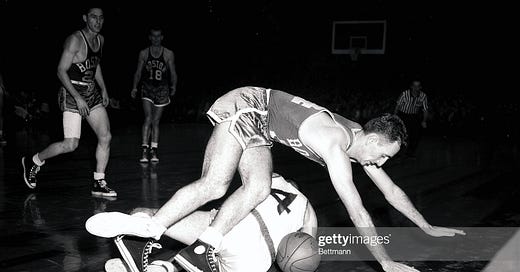After winning the 1950 and 1951 Lost MVP awards, George Mikan narrowly missed out on the 1952 honors thanks to Paul Arizin. The defending Lost MVP Arizin was scooped up by the U.S. Marines, however in the offseason, so he’s out of commission for the next two years.
But don’t fret! We still got plenty of competition to potentially keep Mikan from getting the award back.
Ed Macauley and Bob Cousy are here once again making strong claims for MVP. Dolph Schayes, after a down 1952 season, comes roaring back this year. And in Arizin’s absence, a new scoring machine emerged in Philadelphia. Complicating matters further is figuring out how to assign credit for the New York Knicks’ great season.
Let’s figure this out!
Celtics and Knicks Knee-Cap Themselves
The NBA’s Eastern Division in 1953 was ridiculous. The Knicks, Boston Celtics, and Syracuse Nationals all finished within 1.5 games of first place. (And yes the NBA was still playing an uneven schedule).
The Celtics and Knicks provide a painful deliberation for trying to give out MVP credit. The Knickerbockers had six players finish with scoring averages between 10 PPG and 14 PPG. The Rochester Royals would often have a similar dynamic, but at least year-to-year they had somebody kind of stand above the rest. The Knicks really did not. That’s great when it comes to egalitarian basketball, but terrible for individual awards.
So, uh, I want to have a Knick on the final ballot, but I’m not sure how much to credit Carl Braun, Harry Gallatin, Sweetwater Clifton, and/or somebody else.
As for the Celtics, they had less egalitarianism, but they sure had a BIG THREE. Joining Macauley and Cousy in the ranks of first-class NBA players was Bill Sharman. Macauley (20.3 PPG), Cousy (19.8), and Sharman (16.2) were the only Celts to average double-digits as they once again led the league in team scoring. Boston’s custom by this point.
Schayes in Syracuse
While the guys in Boston and New York were snatching each others’ credit, Dolph Schayes in Syracuse got the best of all worlds. He was undoubtedly the best player on his team, which was also fairly deep. Paul Seymour was the only teammate who could even possibly challenge his title as best player in Syracuse and it wasn’t much of a challenge.
Johnston’s Lonesome Road
If Schayes had the best of all worlds, Johnston had the worst. The Philadelphia Warriors finished with a horrific 12-57 record despite Johnston leading the league in PPG (22.3) and FG% (.452). Johnston was fantastic, but ain’t nobody winning MVP while playing for the worst team in the league.
In fact that Warriors squad would hold the worst win percentage (.174) in NBA history until the hapless 1973 Philadelphia 76ers had a ghastly .110 win percentage.
Fort Wayne—the Knicks of Indiana
The Fort Wayne Pistons had a good 36-33 record, but like the Knicks, they spread the wealth too much for any individual’s own good. They had six players average double-figures in scoring (ranging from 10.0 to 14.3). Lots of solid players: Larry Foust, Frankie Brian, Andy Phillip, Fred Schaus, etc. Ain’t none of them getting an MVP vote, though. Call us back in a year or two.
Lakers Ahoy!
Minneapolis had a league-best 48-22 record. Vern Mikkelsen was pretty much as good as he was the year before, while Mikan took a bit of a dip. Of course a dip from Mikan still meant he was at the top of the NBA. He finished second to Johnston in PPG and led the NBA RPG once again. He was also second only to Johnston in win shares.
With no one like Paul Arizin in 1952 to crash the scene and take clear-cut credit for his team’s startling success, I think Mikan fends off the pack of challengers for what might be the final time.
The Lost MVP Ballot
#5 Harry Gallatin or Carl Braun (New York Knicks) — yeah, I’m copping out. Too hard to choose who to give a ballot spot. Flip a coin.
#4 Bob Cousy or Ed Macauley (Boston Celtics) — yeah, I’m copping out again. Toss the coin again.
#3 Neil Johnston (Philadelphia Warriors) — I cannot stress enough how crappy that Warriors roster was. I know in some regard somebody has to get points on an NBA team, but Johnston led the league in FG% while racking up the points. Not every gunner on a bad team can claim that.
#2 Dolph Schayes (Syracuse Nationals) — Essentially #2 by default since you can single out Schayes’ 17.8 PPG, 13.0 RPG, and 3.2 APG as the key ingredient in the Nationals’ success.
#1 George Mikan (Minneapolis Lakers) — his third Lost MVP in four seasons. And I wouldn’t blame you if you had him as the winner in 1952.
Your boogie song when you get back with your beloved MVP



